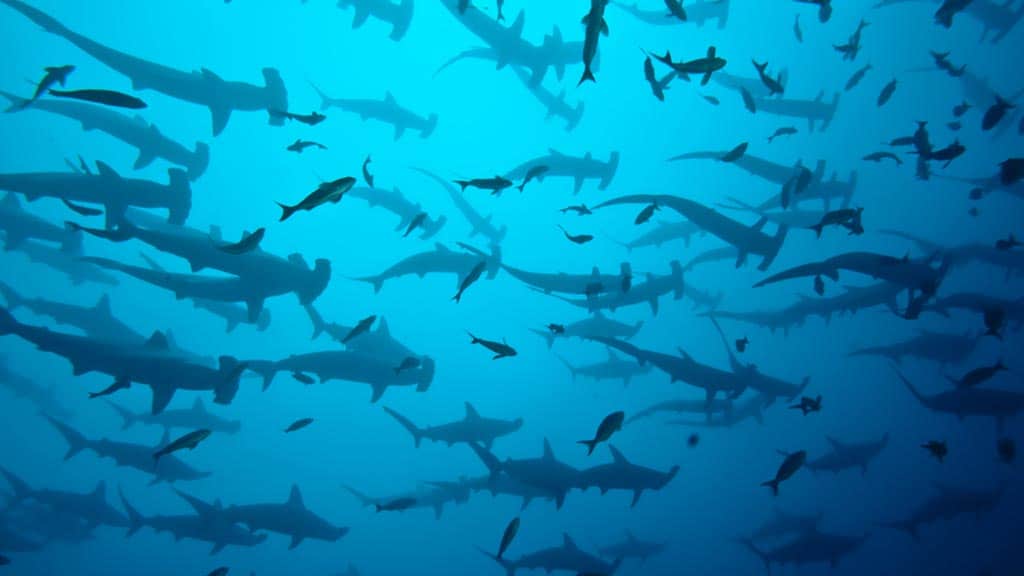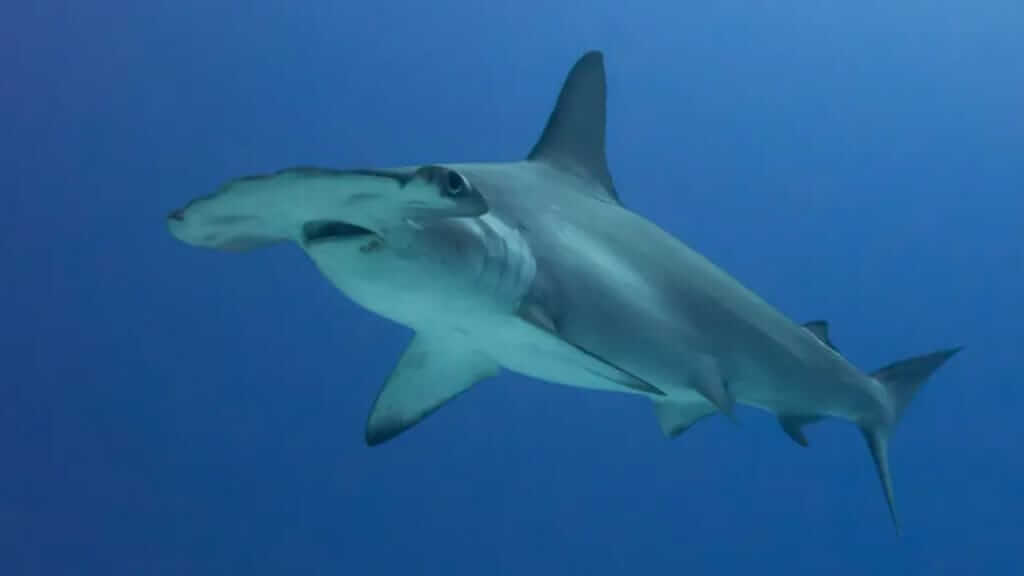GALAPAGOS HAMMERHEAD SHARK
The Galapagos Islands are one of the best places on the planet to dive and snorkel with hammerhead sharks. What makes it so amazing? The Galapagos islands are recognised to have the largest biomass of sharks in the world. Here you don’t just see one or two lone sharks – it’s common to find the Galapagos hammerhead shark in schools of several hundred at a time! Hammerhead shark nurseries have also been found here, putting the Galapagos islands firmly at the center of the hammerhead shark world.
Keep reading for everything you need to know about the Galapagos hammerhead shark. Where and when to see them at Galapagos? Why are they critically endangered around the globe? Plus lots more interesting hammerhead facts and information.
SECURE YOUR GALAPAGOS TRAVEL
Get a FREE personalised quote todayConservation Status: Critically Endangered
Scientific Name:Sphyrna Lewini
How to See a Hammerhead Shark at Galapagos?
A close encounter diving or snorkelling with Hammerhead Sharks is one of the very top Galapagos highlights for tourists! It can be an experience that stays with you for the rest of your life. But not all Galapagos visitors will be lucky enough to find hammerheads. There is a significant element of planning and luck involved.
Where to See Galapagos hammerheads?
If you want to see hammerhead sharks in large schools at Galapagos, then we recommend heading up to the far north-west of the archipelago to Darwin and Wolf Islands. Here you’ll find the largest shark biomass on the planet – an incredible average of 17.5 shark tons per hectare. This often includes large schools of Galapagos hammerhead sharks.
Other Galapagos visitor sites with quite frequent hammerhead shark sightings include: Gordon Rocks (dive site off of Santa Cruz island), Kicker Rock (dive and snorkel site at San Cristobal also known as Leon Dormido), Marchena and Darwin Bay (Genovesa island). But visitors are more likely to see individual sharks at these sites rather than large schools.
When is hammerhead shark season in Galapagos?
There is a reasonably sized Galapagos hammerhead shark population that spend all year at the Galapagos islands. A larger migratory population also pass through Galapagos waters to feed, especially during the warmer months from December to April. Some sources report that January may be the best month to see large schools of Galapagos hammerhead.
Snorkeling and diving with Galapagos hammerhead sharks
For Galapagos hammerhead shark snorkleing you definitely need some luck on your side – there are no guarantees. Try heading to Kicker Rock (August to November/December) or Darwin Bay for the best opportunity. Remember it is the rare possibility to see them that makes it so special when you actually do.
Galapagos Hammerhead diving gives a much higher probabilty of shark sightings. Specialist live aboard Galapagos Scuba cruises head up to Darwin and Wolf islands each week. Three of the best dive yacht options are: Aggressor III, Galapagos Sky and the brand new Tiburon Explorer. If cruising falls outside of your budget then try a day dive at Gordon Rocks instead.
Are hammerhead sharks aggressive? Until now there has never been a global human fatality caused by a hammerhead shark. Of course, they are wild animals so divers need to respect their space and keep a distance. Experienced guides will also be looking out for any possible signs of shark agitation. But in general it is considered perfectly safe to be in the water with a Galapagos hammerhead.
Contact us for a FREE GALAPAGOS TOUR QUOTE, or for more information to plan your Galapagos islands vacation.
GET FREE ADVICE
From a Galapagos destination expert todayEverything you need to know about Galapagos Hammerhead Sharks
How to recognise a Scalloped Hammerhead shark?
Hammerhead Sharks are easy to recognise thanks to their unique head (cephalofoil) that is shaped like a hammer. Their eyes are located on either side of the head of the hammer. This feature improves their vision by providing an increased area of electroreceptors, allowing them to scan the ocean more effectively to sense prey and predators.
The most common species in Galapagos waters is the Scalloped Hammerhead Shark, although Smooth Hammerheads and Great Hammerheads can also be found.
The Scalloped Hammerhead Shark differs from their close cousins by the ‘scalloped’ front edge of their head. A Hammerhead body is slim and streamlined, coloured brown on top and white underneath. Narrow teeth form backwards triangles, perfect for hunting and seizing their prey. Baby sharks measure 50 centimeters long, while an adult hammerhead can grow up to four meters or more.
Galapagos Hammerhead Shark Behavior
Hammerhead sharks breed by viviparous reproduction. That means pups are fed via a placental link inside the mother, and are born alive and ready to swim. Female hammerheads have a long gestation period of 9-12 months, and give birth to dozens of baby hammerhead shark pups at a time. The young are left together in nurseries in shallow coastal waters such as flooded mangrove forests, providing them with food and protection. Here the pups slowly grow for one to two years until ready to fend for themselves in the open ocean. Predation from other shark species is common, so this is a dangerous period in the lives of a young hammerhead shark without their mother.
What do Hammerhead Sharks eat at Galapagos?
The Galapagos Hammerhead Shark diet consists mostly of fish. They prefer sardine, herring or mackerel, and will also occasionally hunt for stingray, squid or crustaceans.
Hammerhead sharks are very skilled hunters. Their electroreceptors are a highly effective way of sensing prey. They move quickly and stealthily, and are capable of turning 360 degrees in a split second to capture a meal.
Due to their high metabolic rate scalloped hammerhead sharks need to consume a large volume of food each day. Young pups in particular need to eat constantly to avoid starvation.
Why are Hammerhead Sharks critically endangered?
The Scalloped Hammerhead Shark is listed as a critically endangered species on the IUCN red list. The high value of their fins means that they are frequently targeted by illegal fishermen to sell on the Asian market. Hammerheads are also at risk to bycatch of trawlers and long-line fishing, where they can become trapped and drown.
Fortunately the Galapagos Marine Reserve is a safe haven for hammerhead sharks and other marine species. Fishing of protected species in Galapagos waters is illegal and strictly controlled. However, migratory shark species like hammerheads and whale sharks have no protection when they leave the safe waters of Galapagos – a fact that is easily exploited. As recently as the summer of 2020, a huge chinese fishing fleet waited at the border of the Galapagos reserve to catch migratory species as they leave safe waters. Whilst legally there was nothing that Ecuador could do, this practise is highly unethical, and hammerhead sharks are one of the species most affected.
The good news is that hammerhead conservation work is underway to provide better protection for hammerhead sharks. Currently nobody has any idea where the pregnant hammerheads that group together at Darwin and Wolf islands go to give birth. So the Charles Darwin foundation has teamed up with other collaborators to tag 15 pregnant female hammerheads. The idea it to track the movements of these mothers-to-be to locate shark nurseries on the coasts of Central and South America. With better understanding of their behavior, the hope is that we can provide better protection along their migratory birthing routes in the future.
Interesting Galapagos Hammerhead Shark Facts
• For millions of years a large Hammerhead Shark nursery remained hidden in plain site at Galapagos. This all changed in 2017 with the discovery of this important Galapagos hammerhead nursery ground in the mangroves on the north west coast of Santa Cruz Island. Ongoing studies hope to unlock the key to better understanding these graceful creatures of the deep, and in doing so help in Scalloped Hammerhead Galapagos conservation efforts.
• A Scalloped Hammerhead Shark can only be outside of the water for two minutes before they suffocate and die. Hammerheads need a constant flow of water to breathe. They pull oxygen into their body from the water, and exhale through their gills.
• Their hammer-shaped head is designed to help them sense other creatures through the process of electroreception. This is the ability to smell and sense other sea creatures by using electric fields and currents.
Book With The #1 Trusted
Galapagos Travel Agency
If you enjoyed this article, then check out our blogs about Whale Sharks at Galapagos or other species of Galapagos shark. We also have informative blogs about Galapagos tropical fish and whale watching at the Galapagos islands.
In conclusion, an encounter with a Galapagos hammerhead shark could be one of your top Galapagos highlights. Just follow our advice and recommendations in this blog to improve your chances of seeing them. Few other dive destinations in the world will get you this close to large schools of hammerhead sharks. We are talking an amazing bucket list experience!




